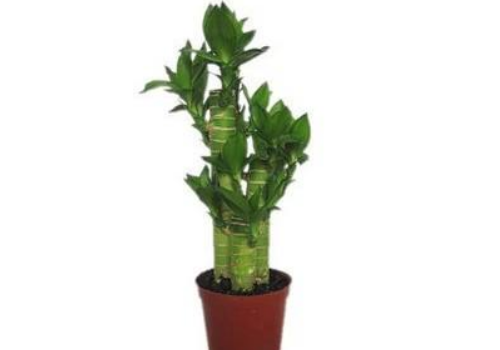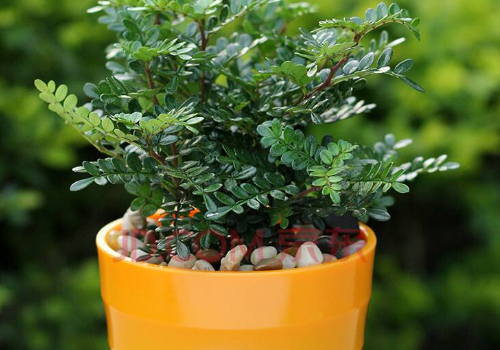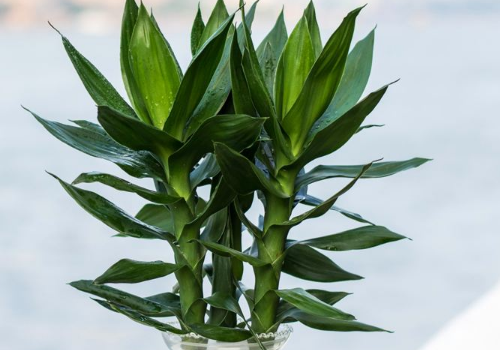What to do if the leaves of lotus bamboo turn yellow? how to raise them by hydroponic culture?
Lotus bamboo and rich bamboo are not much different, can be raised in soil can be raised in water, the moral is also very good, then do you know what to do when the leaves of lotus bamboo turn yellow? How to cultivate hydroponics?
What if the leaves of the lotus bamboo turn yellow:
The main results are as follows: 1. The sun is burning yellow and strong sunlight shines directly on the lotus bamboo, which is easy to cause the withering of the leaf tip and leaf edge, and the yellow spot appears in the sunny part of the leaf. Move the flowers and trees to the shade.
2. Lack of light and shade for a long time, the leaves can not get enough sunlight, can not form chlorophyll, the whole leaves turn yellow and fall off, supplementary light can avoid the disease.
3. Excessive fertilization or excessive concentration caused the yellowing of lotus bamboo, showing dry brown at the tip of the new leaves, generally thick but not glossy, and concave and convex, and the old leaves were scorched yellow. Fertilizer should be stopped immediately and some fertilizers should be washed with a large amount of washing.
4. the lack of fertilization yellow shows that the color of the young leaves becomes light, yellow or light green, while the old leaves are relatively normal or gradually change from green to yellow. Usually apply thin fertilizer frequently and add some alum water at the right time. Because lotus bamboo is a foliage plant, nitrogen fertilizer should be applied.

How to grow water-cultured lotus bamboo:
The air is too dry, spray water sooner or later.
2. scattered light maintenance, too strong light is easy to sunburn, lack of light to grow branches and leaves.
3. Change water with sun-dried tap water, sooner or later. Change every 15 days or so, then add foliage plant nutrient solution.
4. The temperature should not be lower than 10 ℃.
Now you know why the lotus bamboo turns yellow.
Can lotus bamboo be hydroponically cultured? how to hydroponically cultivate lotus bamboo / one bottle and one bottle in three steps
Lotus bamboo, just like its name, its leaves like lotus flowers, stems like bamboo, the overall plant shape is beautiful, raised at home is very ornamental. However, in indoor culture, many flower lovers prefer water culture to soil culture. Can lotus bamboo be hydroponically cultivated? If you can, how can lotus bamboo be cultured in water? Next, let's go with the editor to take a look at the aquaculture method of lotus bamboo.
Can lotus bamboos be hydroponically cultured?
Lotus bamboo is a kind of tenacious plant, it likes wet environment, and it can survive by inserting it into water, so can lotus bamboo be hydroponically cultivated? Obviously, you can. It is understood that lotus bamboo is a kind of perennial brittle green plant, which is not only suitable for soil culture but also very suitable for hydroponic culture, and the ornamental value of hydroponic lotus bamboo is higher!
Second, how to cultivate lotus bamboo in water, three steps are in place.
1. One branch
One branch, that is, on the soil-cultured lotus bamboo, select the robust branches and cut them off as water-cultured seedlings. After that, in order to make it easier to take root, we should also deal with the selected branches accordingly: cut off all the leaves at the base, and then cut the base into an oblique cut with a knife.
2. One bottle
A bottle, that is, the container of hydroponic lotus bamboo. In this regard, the editor recommends that everyone use a good-looking transparent glass container, so that it is not only good to observe its rooting, but also to see the white roots of the lotus bamboo look good against the water.
3. Insert
Once inserted, insert the water-cultured seedlings into a container filled with 2 canisters and 3 water, and keep the water changed every 3-4 days before rooting. After doing so, do not move the glass bottle for 10 days, the lotus bamboo will grow pure white roots in 15 days, followed by hydroponic conservation.
3. Aquaculture methods of lotus bamboo
1. Change the water to add water: after the lotus bamboo takes root, don't change the water so frequently. When you find that the water is reduced, you can add a little water. The reason for this is that if the water is changed frequently, it will cause the leaves of lotus bamboo to turn yellow.
2. Appropriate fertilization: according to the actual situation, fertilizer can be applied every 30 days or so on average. Of course, the fertilizer is a special nutrient solution for hydroponics. Just put a few drops when adding water. Moderate fertilization can keep the leaves green and stretched for a long time.
3, avoid cold wind blowing: about the water culture method of lotus bamboo, there is one thing we must not forget, that is, the location. You should keep the glass bottle away from the air conditioner or the wind of the electric fan to avoid yellowing and withering the edge or tip of the lotus bamboo leaves as a result of being blown by the cold wind.
What about the yellow leaves of asparagus? what about the yellowing of asparagus leaves? how to cultivate asparagus?
Asparagus leaves slender and beautiful, dense, such as feathery, elegant plant shape, unique charm, deeply loved by people, is a more common indoor foliage flowers. Friends who have raised asparagus will find that the leaves are easily yellowed in the process of breeding. What if they encounter the yellowing of asparagus leaves? Today, the editor will teach you some conservation methods of asparagus. The reason for the yellowing of asparagus leaves
1. The temperature is too high. Although asparagus likes to be warm, it should not be placed near the fire for a long time, otherwise the leaves of the whole branch will turn yellow and fall off, and the stem will dry up. 2. Direct exposure. Asparagus can not shine directly in the strong sun, which will cause the branches and leaves to be withered and yellow. in addition, when asparagus is exposed to strong light for a long time, the plant is stagnant at first, and then the leaves are yellow. 3. Improper watering. Asparagus likes to be wet, if you ignore watering, or only irrigate the topsoil, the roots do not absorb enough water, and the stems and leaves turn yellow slowly. But also do not accumulate water in the flowerpot, the water is easy to rot roots and leaves withered and yellow. 4. There is not enough light. Asparagus likes warmth and is placed in a shady environment for a long time, and the plant grows weakly and then turns yellow. It is best to put it in a place with plenty of sun in winter, if you put it in a place where there is not enough light, coupled with poor ventilation and cold, it is easy to cause withered and yellow branches and leaves. If such a phenomenon occurs, it is necessary to replace asparagus with new trainers.
5. Improper fertilization. It is necessary to fertilize asparagus regularly so that it has enough nutrients, and the supply of nutrients falls short of demand, and the branches and leaves will turn yellow. Excessive concentration or the application of not yet mature fertilizer is easy to burn seedlings even if dry, long-term not topdressing, will also be fat and yellowing. 6. Suffer frost injury. Asparagus likes to be warm, and the temperature is low in winter. If the indoor temperature is lower than 5 ℃, plastic cover should be used to keep out the cold, otherwise it is easy to freeze and wither. 7. Infected with diseases and insect pests. Once asparagus is infected with shell insects and other pests, it will also cause withered and yellow branches and leaves, so it should be controlled in time. 8. Improper placement. If asparagus is placed next to the TV, the leaf tip will gradually dry up. The method of yellowing the leaves of asparagus
1. Proper placement. Asparagus likes a slightly humid environment that is half-yin and half-yang. First, avoid exposure to the sun, but where you can see the sun; second, feel the air circulation; third, stay away from the stove and TV; fourth, keep warm, the minimum room temperature should not be less than 5 ℃. If the room temperature is 0: 4 ℃, use a plastic cover to keep out the cold. 2. Regulating fertilizer and water. It is not necessary to apply fertilizer too frequently during the growth period of asparagus, generally, it is only suitable for topdressing in spring and autumn, applying thin rotten manure or low concentration compound fertilizer solution every 10 to 15 days, or applying rice water and bean juice water. High temperature in summer and low temperature in winter are not suitable for fertilization. Fertilization should not be excessive and not out of date. Watering should be neither dry nor watered, once watered thoroughly when dry, and no waterlogging is left on the basin. Spray water regularly to remove dust from the foliar surface. 3. Plastic surgery in time. Asparagus is easy to grow in clusters, first, it should be combined with changing pots to add soil to trim the old and residual whisker roots, dredge the redundant stems and leaves, avoid excessive consumption of nutrients, and play the role of maintaining roots and protecting leaves; the second is to cut off the local yellowing leaves; the third is to cut off the stems and leaves that are yellow at the same time. Nursing care of asparagus leaves yellowing in different periods, the focus of conservation of asparagus is also different. Asparagus can be fertilized once in late November, moved indoors since December, watered twice a month (soaking basin method), replenished light with fluorescent lamps on rainy days, and sprayed once every two or three days. Asparagus can be moved out of the room in March next year to fully accept the light, but to avoid direct glare. The moisture of the basin soil can be determined whether it needs watering according to the daily weather conditions and the dry humidity of the basin soil, and there is a spray almost every day in the morning and evening. Fertilize water (urea solution is available) once a week. From early May to late August, plants need to be indirectly exposed to sunlight or shade, and should not be exposed to sunlight. 2Mel should be watered once every 3 days, and the surrounding environment should be sprinkled more to improve the air humidity. In this way, asparagus can maintain its exuberant growth momentum. Note that when the summer temperature is too high, you can put the plant in the shade, but can not put the plant in the air conditioner, it is easy to cause the phenomenon of yellow leaves. From September to November, the plant is removed from under the tree and placed directly on the platform. The pot is transferred once a week, and the management of fertilizer and water is the same as that of spring conservation. Conclusion: although asparagus has the characteristic of evergreen for many years, if it is not maintained properly, it will often appear the symptom of yellowing of branches and leaves, which will affect the ornamental effect. After understanding the measures and maintenance methods for the yellowing of asparagus leaves, we should pay more attention to the process of cultivating asparagus. For more information on decoration, you can log on to Aiyouwang. [more information]
| | Flower language of red roses | formaldehyde-free plants | function of green roses | efficacy and function of Hangzhou white chrysanthemum | when does the lotus blossom | | efficacy and function of jasmine tea | Happiness tree picture | function of lavender | Flower language of daisies | efficacy of Kunlun snow chrysanthemum | | Culture method of Junzi Orchid | Culture method of Ivy | cultivation of ginkgo trees | Orchid varieties | | Kangnai | Is it good to raise Xin | triangular plum culture method | efficacy and function of yellow chrysanthemum | Gesang flower language | is calla lily poisonous | | what plant absorbs formaldehyde | potted flower picture | efficacy of jasmine tea | efficacy and function of woody incense | hydroponic rich bamboo |
- Prev

How to Cuttage Propagation of Pepper Wood and the Modeling method of Bonsai
Pepper wood has many functions, so now there are many people who want to raise it. How can pepper wood be propagated by cuttings? Bonsai modeling method: how to cuttage propagation of pepper wood: 1. Walnut is also very important in the time of cutting, and cutting is best carried out in the Spring and Autumn period.
- Next

How does the lotus flower bloom?
Lotus leaves are very good meaning, home water is also more, then you know how to raise lotus bamboo to grow well? Can it bloom? How does the lotus bamboo grow well? How does the soil reproduce and how does the lotus bamboo reproduce? There are two main types of lotus bamboo propagation, one is soil propagation, and soil propagation is insertion propagation.
Related
- Fuxing push coffee new agricultural production and marketing class: lack of small-scale processing plants
- Jujube rice field leisure farm deep ploughing Yilan for five years to create a space for organic food and play
- Nongyu Farm-A trial of organic papaya for brave women with advanced technology
- Four points for attention in the prevention and control of diseases and insect pests of edible fungi
- How to add nutrient solution to Edible Fungi
- Is there any good way to control edible fungus mites?
- Open Inoculation Technology of Edible Fungi
- Is there any clever way to use fertilizer for edible fungus in winter?
- What agents are used to kill the pathogens of edible fungi in the mushroom shed?
- Rapid drying of Edible Fungi

